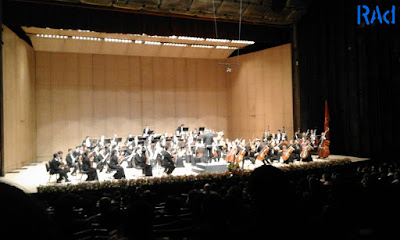 |
| Violinist Diomedes Saraza, Jr. |
Some years back, I’ve grown sick and tired of Felix Mendelssohn’s Violin Concerto in E minor, Op. 64 after having to sit through at least four competitors play it to varying degrees of success at the National Music Competitions for Young Artists (NAMCYA). I told myself that I’d stay away from that piece so I wasn’t brimming with excitement when I learned that this concerto was to be played by Diomedes Saraza, Jr. with the Philippine Philharmonic Orchestra under the baton of principal conductor/music director Yoshikazu Fukumura. Thankfully, a masterful performance was delivered by all convincing me that the Mendelssohn was worth hearing live again.
The first order of the concert was Wolfgang Amadeus Mozart’s
Symphony No. 28 in C major, K. 200 that was light, fun, and fairly easy to
grasp even to the casual/first time concertgoer. The orchestra was crisp, sharp, and precise making it easy for me to forgive their not so cohesive first note. It
was such a great relief that there weren’t any applause in between movements
that made the momentum build up until the final note of the symphony’s frolicking
finale.
Next up was the violin concerto with Diomedes and like what
I said above, it was such a compelling display of how this Mendelssohn piece should
be. The initial dread of hearing the all too familiar first two measures was then replaced with an appreciation as I began taking note of the concerto's form and structure as the performance went along. Deconstructing it in my head made me fully aware of how expertly crafted this piece was which is probably why this was chosen by the NAMCYA competitors years ago. Having said this. I would still prefer not to encounter any more Mendelssohn violin concertos for the next couple of years. I got more
than amply rewarded though with his encore of Eugène Ysaÿe’s Violin
Sonata No. 3 in D minor, Op. 27 “Ballade”. Having something new and unfamiliar was a perfect foil for an overplayed
concerto.
Making up the second half is Edward Elgar’s Variations on an
Original Theme, Op. 36 which is popularly known as the Enigma
Variations. If I had been impatient, I
would’ve let my mind wander off until Variation IX Nimrod, the most
popular among the 14 variations and the one that is regularly played on its
own. But having sat through the Mendelssohn earlier, being attentive to the Elgar was a
walk in the park. And Fukumura was able to convey the affection that Elgar felt
towards the dedicatee of each variation. The richness of the viola and the
cello were evident in Variations VI Ysobel and Variation XII B.G.N. respectively. Nimrod, I think, came and went too quickly. I wish that they played it a tad slower paving more
way to tug at the heart strings or like what a music major told me, “to hurt
more”. Those who expected that Nimrod would be heard again as an encore were
disappointed as it was Variation XII B.G.N. with the solo cello that was repeated.
This concert by the Philippine Philharmonic Orchestra somewhat signaled that the music season has truly resumed after all the merry making of the holiday season. The regulars at the Cultural Center of the Philippines who were conspicuously absent the previous PPO concert were back. And it greatly pleased me to see groups of what looked like high school students and also seminarians there too. For me, this mix of the old and the young among the audience just reflected this season's theme of Timeless Classics, New Beginnings which bodes well for the rest of the new year.



No comments:
Post a Comment